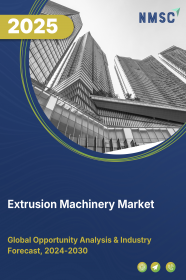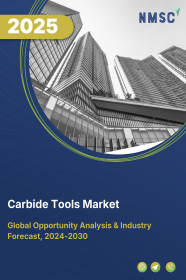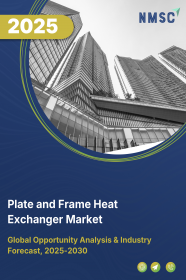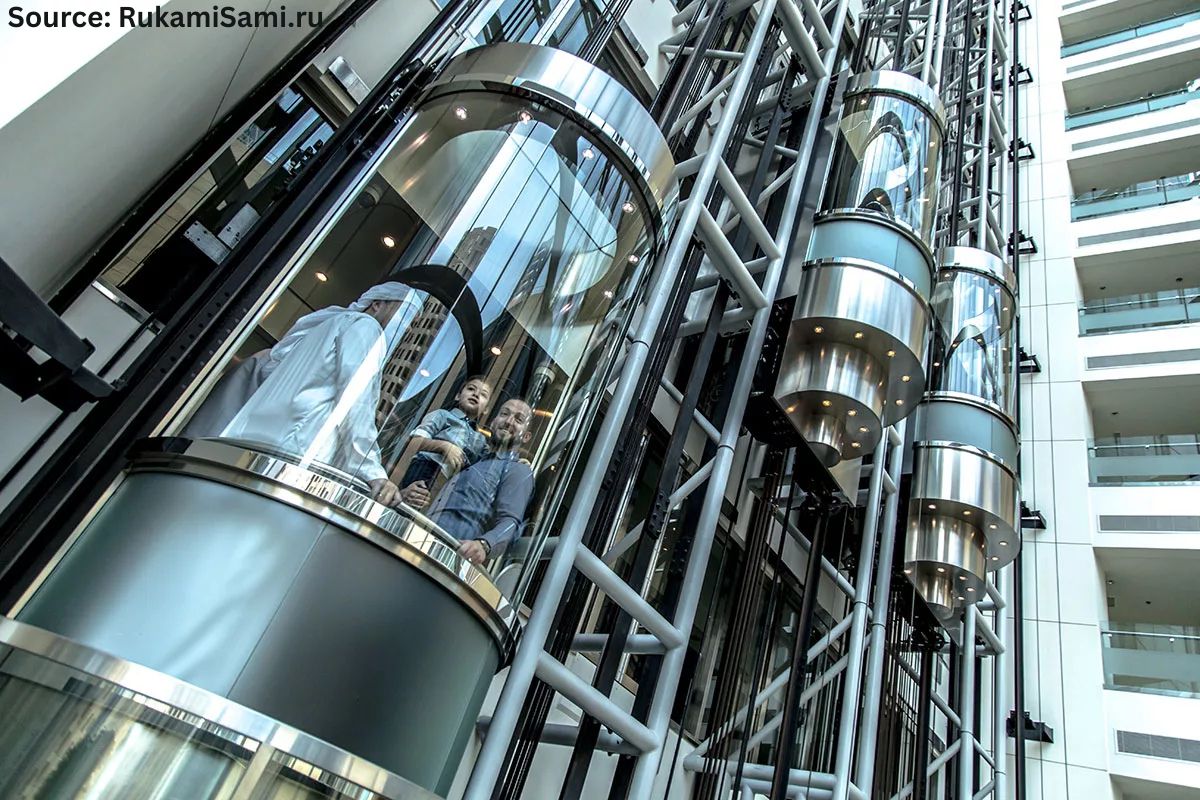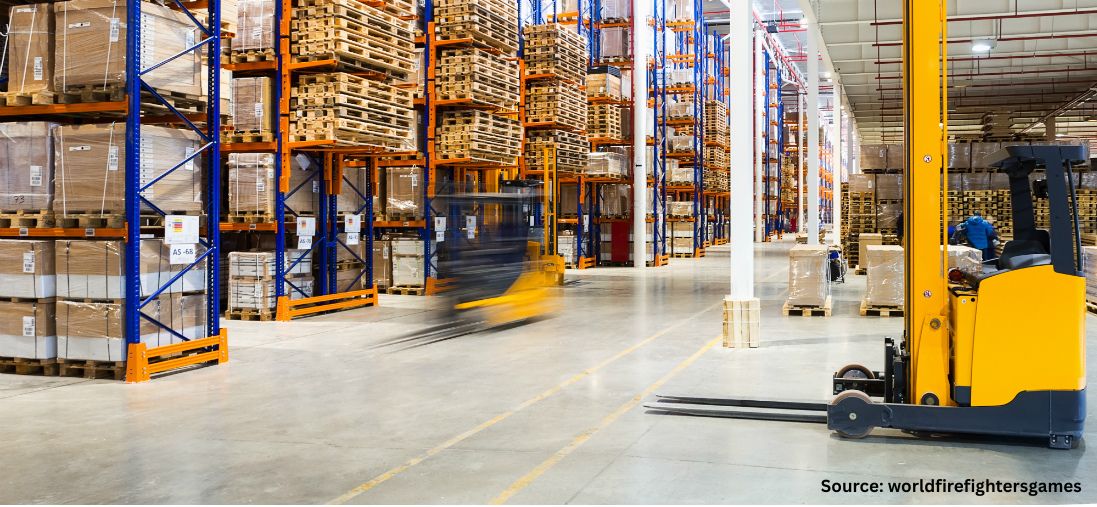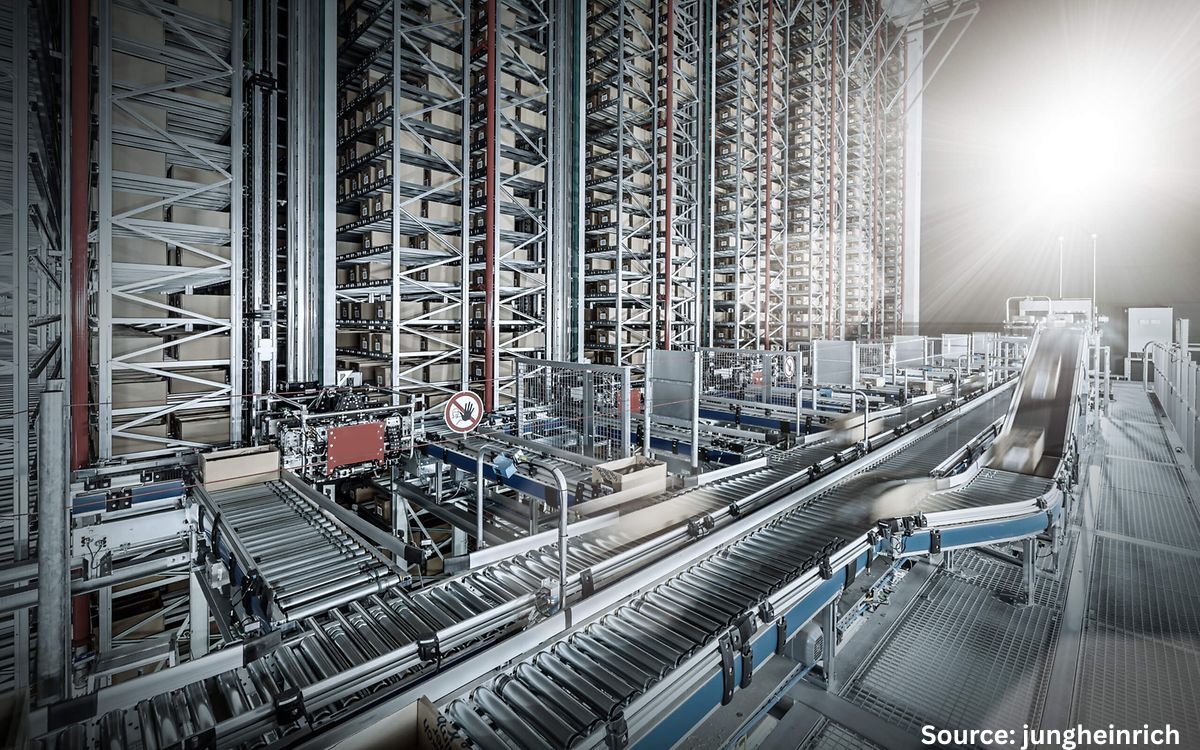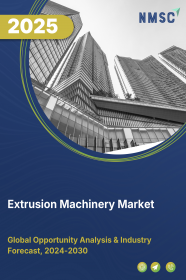
Extrusion Machinery Market by Type (Direct Extrusion, Indirect Extrusion, and Hydrostatic Extrusion), by Machinery Type (Single-Screw Extruders, Twin-Screw Extruders, and RAM Extruders), by Material (Plastic, Metal, Rubber, and Others), by Process (Cold Extrusion, Hot Extrusion, Friction Extrusion, & Other Processes) by Solution (New Sales and Aftermarket) and by End-User Industry (Construction, Automotive, and Others) – Global Opportunity Analysis and Industry Forecast, 2025-2030
US Tariff Impact on Extrusion Machinery Market
Trump Tariffs Are Reshaping Global Business
Extrusion Machinery Market Overview
The Global Extrusion Machinery Market size was valued at USD 7.96 billion in 2024 and is expected to be valued at USD 8.32 billion by the end of 2025. The industry is further predicted to reach USD 10.37 billion by 2030 with a CAGR of 4.5% from 2025 to 2030.
The global extrusion machinery market is experiencing robust growth, driven by surging demand for plastic products, rapid expansion of end-use industries such as packaging, automotive, and construction, and continuous technological advancements enhancing machinery performance and versatility. However, high installation and capital costs associated with advanced extrusion systems remain a significant restraint, particularly for small and medium-sized enterprises. On the other hand, rising sustainability demands and the push for circular economy practices present a strong opportunity for manufacturers to innovate with eco-friendly and recycled material processing solutions, paving the way for long-term, responsible growth.
Surging Plastic Demand Drives Robust Growth in the Market
The unwavering increase in demand for plastic products is a primary engine driving the expansion of the extrusion machinery industry. Plastic products, versatile and cost-effective, are integral to numerous sectors, from everyday consumer goods to sophisticated industrial components. As populations grow and economies develop, the need for plastic packaging for food and beverages, plastic components in automobiles for lightweighting, and PVC pipes and profiles in the expanding construction sector continues to surge. This escalating demand directly translates to a higher requirement for efficient and advanced extrusion machinery capable of producing these plastic items at scale, thereby boosting the market size and growth potential of the extrusion equipment industry.
End-Use Industry Growth Drives the Market Growth
The substantial growth within key end-use industries acts as a significant catalyst for the extrusion machinery industry. The packaging sector, driven by consumer needs and stringent hygiene standards, heavily relies on plastic films and sheets produced by extrusion machines. Similarly, the automotive industry's pursuit of lighter and more fuel-efficient vehicles necessitates the use of extruded plastic parts. Furthermore, the expanding construction industry utilizes extruded PVC pipes, window frames, and insulation materials. Even the food processing sector employs extrusion technology to create a wide array of products. This widespread application across diverse and growing industries ensures a consistent and increasing demand for extrusion machinery, contributing significantly to the overall extrusion machines share and industry size.
Technological Advancements in Extrusion Machinery Fuel Market Growth
Continuous technological advancements and innovations in extrusion processes are crucial drivers propelling the market forward. Manufacturers are consistently developing more efficient, precise, and versatile extrusion machines. For instance, the introduction of twin-screw extruders known for their superior mixing capabilities and high productivity has significantly impacted the market. The integration of AI and machine learning allows for real-time monitoring and optimization of processing parameters, leading to improved product quality and reduced waste. Furthermore, advancements in die design and automation enhance the ability to produce complex profiles and increase output rates. These ongoing innovations not only improve the performance of extrusion machinery but also broaden their applicability across various materials and product types, fueling market growth and offering a competitive edge to manufacturers adopting these advanced technologies.
High Installation Costs Hinders the Market Growth
A significant challenge in the extrusion machinery industry is the high initial investment cost associated with acquiring new extrusion equipment. Modern, high-performance extrusion lines, especially those incorporating advanced automation and control systems, represent a substantial capital expenditure. This high upfront cost is a significant barrier for small and medium-sized enterprises (SMEs) looking to enter the market or upgrade their existing equipment. While these advanced machines offer long-term benefits through increased efficiency, higher output rates, and improved product quality, the initial financial outlay daunting. This restraint slows down the adoption of newer technologies and limit the growth potential, particularly in regions with limited access to capital or higher financial risks.
Rising Emphasis on Sustainability and Recycling Creates Future Market Opportunities
The increasing global emphasis on sustainability and recycling presents a significant opportunity for players in the extrusion machinery industry. The growing awareness of environmental concerns and the push for a circular economy are driving demand for extrusion technologies that process recycled plastics and produce more sustainable products. This includes machinery designed for efficient recycling of post-consumer and post-industrial plastic waste. Innovations in extrusion that allow for the incorporation of higher percentages of recycled content without compromising product quality, as well as the development of machinery for processing biodegradable and bio-based polymers, are gaining traction. Manufacturers who invest in developing and offering such sustainable extrusion solutions are well-positioned to capitalize on this growing market demand and contribute to a more environmentally responsible industry.
For instance, in March 2025, KraussMaffei launched the Edelweiss Recycling line, an advanced twin-screw extrusion system designed to process up to 100% recycled plastics, including PET and PP, with enhanced energy efficiency and high-quality output for circular economy applications.
Market Segmentations and Scope of the Study
The extrusion machinery industry report is segmented based on type, machinery type, material, process, solution, end-user industry, and region. By type, the market is categorized into direct extrusions, indirect extrusions, and hydrostatic extrusion. Based on machinery type, it is classified into single-screw extruders, twin-screw extruders, and RAM extruders. On the basis of material, the market is divided into plastic, metal, rubber, and others. By process, it is segmented into cold extrusion, hot extrusion, friction extrusion, and other processes. Based on solution, the market includes new sales and aftermarket. By end-user industry, the market is segmented into construction, automotive, consumer goods, food & beverage, healthcare, aerospace & defense, and others. Regional breakdown and analysis of each of the aforesaid segments include regions comprising North America, Europe, Asia-Pacific, and RoW.
Geographical Analysis
In North America, the extrusion machinery industry is a significant player, driven by its advanced manufacturing technologies and stringent environmental regulations. Specifically, the USA has contributed substantially to this growth due to demand from the automotive and aerospace industries. The region exhibits steady growth in the plastic sheet extrusion machines industry. Companies in North America are likely focusing on high-performance machines to meet the demands of these advanced sectors.
Europe represents another crucial region for the extrusion machinery industry. A key characteristic of this market is the strong emphasis on sustainability and energy-efficient manufacturing solutions. Furthermore, the presence of a strong food and beverage industry and stringent government regulations regarding food safety act as drivers for the adoption of extrusion technologies. While the region is experiencing growth, there are instances where domestic production, such as extruded snacks, struggles to keep pace with the increasing demand, leading to reliance on international supply chains. Europe follows Asia-Pacific in terms of market share in the plastic sheet extrusion machines market, driven by stringent regulations and technological advancements.
The Asia-Pacific region emerged as the dominant force in the extruder market, and the market share is attributed to a strong industrial base, rapid urbanization, and substantial growth in key sectors including construction, packaging, automotive, and electronics. China, India, and Japan are central to this expansion. China's robust manufacturing in automotive, consumer goods, and packaging, fueled by urbanization and infrastructure projects, drives demand for extruded products. Similarly, India's expanding construction and automotive sectors are significant contributors. The Asia-Pacific region also leads the plastic sheet extrusion machinery market due to rising industrialization and demand from the packaging and construction sectors.
The Rest of the World, which includes regions like Latin America and the Middle East & Africa, presents notable growth potential in the extrusion machinery market. This growth is largely driven by expanding construction and infrastructure sectors. Brazil is specifically highlighted as a fast-growing market within this broader category. Additionally, Saudi Arabia is poised for substantial growth, fueled by government initiatives promoting industrial expansion and rapid urbanization, with increased adoption of extruded plastic pipes in the region.
Strategic Innovation and Positioning Adopted by Key Players
Key players in the global extrusion machinery industry are strategically focusing on technological advancements and sustainability to maintain their market share and tap into significant growth potential. Recent developments include the integration of digitalization and advanced automation like AI-powered quality control systems1 and smart extrusion systems for real-time process monitoring, which boost efficiency and reduce costs. For instance, companies are investing in machines capable of processing advanced materials and recycled plastics, reflecting the increasing emphasis on eco-friendly practices and catering to the rising demand for sustainable manufacturing solutions. However, these manufacturers face challenges such as volatile raw material prices and the constant pressure to enhance energy efficiency. The high level of market competition necessitates differentiation through product innovation and customization to meet diverse end-user requirements in sectors like automotive, packaging, and construction. Looking ahead, opportunities lie in the expanding demand for extruded products, particularly in rapidly industrializing regions like Asia-Pacific and emerging markets such as Brazil and India, which exhibit strong growth potential driven by infrastructure development and increasing consumption. Strategic collaborations, mergers, and acquisitions, as seen with US Extruders and Vintech, also represent key strategies for expanding market presence and enhancing product portfolios in this dynamic industry size.
KEY BENEFITS
-
The report provides quantitative analysis and estimations of the extrusion machinery market from 2025 to 2030, which assists in identifying the prevailing market opportunities.
-
The study comprises a deep dive analysis of the extrusion machinery market including the current and future trends to depict prevalent investment pockets in the market.
-
Information related to key drivers, restraints, and opportunities and their impact on the extrusion machinery market is provided in the report.
-
Competitive analysis of the players, along with their market share is provided in the report.
-
SWOT analysis and Porters Five Forces model is elaborated in the study.
-
Value chain analysis in the market study provides a clear picture of roles of stakeholders.
Extrusion Machinery Market Key Segments
By Type
-
Direct Extrusions
-
Indirect Extrusions
-
Hydrostatic Extrusion
By Machinery Type
-
Single-Screw Extruders
-
Twin-Screw Extruders
-
RAM Extruders
By Material
-
Plastic
-
Metal
-
Rubber
-
Others
By Process
-
Cold Extrusion
-
Hot Extrusion,
-
Friction Extrusion
-
Other Processes
By Solution
-
New Sales
-
Aftermarket
By End-User Industry
-
Construction
-
Automotive
-
Consumer Goods
-
Foods & Beverage
-
Healthcare
-
Aerospace & Defense
-
Others
By Region
-
North America
-
The U.S.
-
Canada
-
Mexico
-
-
Europe
-
The UK
-
Germany
-
France
-
Italy
-
Spain
-
Denmark
-
Netherlands
-
Finland
-
Sweden
-
Norway
-
Russia
-
Rest of Europe
-
-
Asia Pacific
-
China
-
Japan
-
India
-
South Korea
-
Australia
-
Indonesia
-
Singapore
-
Taiwan
-
Thailand
-
Rest of Asia Pacific
-
-
RoW
-
Latin America
-
Middle East
-
Africa
-
Key Players
-
Milacron, LLC
-
Japan Steel Works, Ltd.
-
Bc Extrusion Holding GmbH
-
Graham Engineering
-
Toshiba Machine Co., Ltd.
-
Vulcan Extrusion
-
Omipa Extrusion
-
R & B Plastics Machinery LLC
-
MAS Maschinen-und Anlagenbau Schulz GmbH
-
Jiantai Plastic Machinery Ltd.
-
Bausano & Figli S.p. A.
-
Leistritz Extrusionstechnik GmbH
-
Kabra ExtrusionTechnik Ltd.
-
Sumitomo Heavy Industries (Thailand) Ltd.
-
RDN Manufacturing Co., Inc.
REPORT SCOPE AND SEGMENTATION
|
Parameters |
Details |
|
Market Size in 2024 |
USD 7.96 Billion |
|
Revenue Forecast in 2030 |
USD 10.37 Billion |
|
Growth Rate |
CAGR of 4.5% from 2025 to 2030 |
|
Analysis Period |
2024–2030 |
|
Base Year Considered |
2024 |
|
Forecast Period |
2025–2030 |
|
Market Size Estimation |
Billion (USD) |
|
Growth Factors |
|
|
Countries Covered |
28 |
|
Companies Profiled |
15 |
|
Market Share |
Available for 10 companies |
|
Customization Scope |
Free customization (equivalent up to 80 working hours of analysts) after purchase. Addition or alteration to country, regional, and segment scope. |
|
Pricing and Purchase Options |
Avail customized purchase options to meet your exact research needs. |

















 Speak to Our Analyst
Speak to Our Analyst



